The Concrete Bride
Note: This piece is both prequel and sequel to my short story 'Beware The Owls’ Herald’
By late 1878, the dream of completing the Great East River Bridge between Manhattan and Brooklyn was over budget, over committed, and its backers deeply overextended. In an age which had seen the country move from iron to steel, and a construction boom which forced the introduction of elevators into the city for the first time, the anxiety to get the bridge over the finish line and over the river was becoming palpable. In the cacophony of the thousands of workers who would flood the worksite every morning, the cheap daily immigrant labor so valued by the investors, corners were being cut. The metal rope invented by John Roebling, the bridge’s designer, was often compromised with local materials instead of the more resilient but more expensive steel from Pennsylvania. The turnover in workers suffering from decompression sickness, the bends, was slowing the pace of sinking of the bridge’s enormous gothic spires into the river’s bedrock to a crawl. The weather too had been particularly cruel during the winter of 1877, but with deadlines already long overdue, workers from the temperate climates of Italy and Germany were simply told to pack an extra jacket.
Despite all its risks, the promise of working on such a prestigious and iconic monument to the country’s prosperous future pulled thousands of hopefuls across the ocean. Like his father before him, Joseph Bianchi had known a life back home before making the journey to the new world. He’d been accepted as one of the huddled masses who sought the adventure only America seemed to hold, especially as Europe descended further and further into economic decline and the misery of the collapse of empire. Joseph was the middle child of a proud Sicilian family. Good with his hands and on the right nights, a genius in the kitchen. He knew the importance of family, and how food was a universal peacemaker. He baked his own bread as much as he made his own furniture, and when the call went out to the world to join in the grand project of uniting Manhattan and Brooklyn, he saw the opportunity to make his dreams a reality.
On the lengthy voyage from Palermo to the Battery, he’d met Maria DeLuca and been spellbound. She was new money, but no-one dared ask where the source of her family’s recent and unexpected wealth had come from. All they knew was that she’d gone from a one-room schoolhouse on the outskirts of Ribera to traveling first class across the Atlantic in the finest clothes any of her local friends had seen. She frequently wrote home, as she’d once read in one of the ladies’ magazines she’d had shipped from Paris, that being a lady of letters was the height of sophistication in polite society. That she still wrote in her original child-like script didn’t bother her. It was simply the act of writing and having sent the letters in the first place which became paramount. Never mind they looked as if they were scrawled by an infant. As she puffed a light spray of scent across the letter’s back, she contented herself in knowing that she too, was now doing the same things the ladies of her magazines were doing.
Joseph and Maria seemed like such an unlikely couple. But she made him laugh and he made her breakfast. As they arrived into Ellis Island they committed to keep in touch, and over time their romance deepened. Joseph would meet Maria after his shift working on the bridge, and they would stroll through Battery Park and over to the Hudson River, marveling at what was coming out of the ground as the new Manhattan was being built. Joseph’s clothes would dirty hers, but neither of them seemed to notice. In the boom of the new city, they had found each other, and Joseph, himself becoming a man of letters, wrote home to ask for Maria’s hand in marriage. When months later the positives arrived, they became husband and wife on the steps of City Hall.
Joseph worked hard to give Maria everything she wanted in life. But he was also being asked to give everything he had to finish the bridge on time. As deadlines came and went, Roebling cut a deal with the Mayor, promising the bridge would be finished in time to welcome President Chester A. Arthur during his scheduled visit in early 1883. With such a weight thrust upon the project, efforts which had already been doubled, tripled. Joseph was assigned to the new night shift, illuminated by Edison’s recent invention of the floodlight and for which the project had to borrow the lights from Brooklyn’s Capitoline Grounds. As the bridge neared completion, there was no evening baseball. As Maria had taught Joseph to become a man of letters, so Joseph had taught Maria to bake. And every evening Maria would package up a small number of pies for Joseph to fortify himself with through the long and often bitter nights.
As Joseph tucked into his evening’s salt pork and potato pie on the evening of Wednesday February 15th 1882, he noticed something different. He always took his breaks on top of the Manhattan side tower, from which he had the most spectacular view of the East River skyline. But as he bit into his dinner he paused and noticed something unusual. Something shining in the distance. A pulsing, glowing green dot, high above Herald Square. It had caught his attention just long enough to know that this hadn’t been there on previous nights, no matter how clear they’d been. And it didn’t just pulse, it was glowing with irregular frequency. Was it signaling something? A form of code between the newly minted skyscrapers of the city? Like Gatsby reaching out across the Long Island Sound, he leant his arm forward toward the light, and in doing so dropped his pie. But as he knelt down to retrieve it, he had made the fateful error of untethering himself to the safety harness which would usually hold him secure. Grasping only the fresh crisp air of the clear night, he stumbled backwards off the ledge which had been so familiar to him, but would now take his life. As he fell the two hundred feet between the crest and the river below, he caught the green pulse one last time before the icy river took him.
When news reached Maria the following morning that there had been a terrible accident involving Joseph, her grief swiftly turned to violence. She marched down to Roebling’s office, who by now had become well versed in dealing with the hysterical protestations of the deceased’s relatives. They assured her she would be compensated upon the bridge’s completion, and advised her to go home and rest. As Maria passed the line of other grieving widows and mothers, she felt the price of progress rip her heart out. Afforded no closure, and with no details of what had happened to him, her grief propelled her to believe that he had survived the accident. That he had taken a blow to the head and was simply lost and waiting for her somewhere, perhaps on the banks of the Fulton Ferry. She retraced his steps from the fateful night from what she gathered from those who had worked closely with him, with little success. But as she ventured deeper into the construction site, she took greater and greater risks to get the information her heart told her she needed. The more restricted the area, the more likely he might be there waiting for her.
As she edged nearer and nearer to a truth she felt was within grasp, her dress caught in the cement pouring mechanism left running overnight. She screamed in terror as the machine, unattended, began gathering in her dress as it poured out concrete into the final supporting struts of the bridge. Like Joseph, her screams dissolved in the East River’s piercing wind. The only exit was to tear the dress, but in doing so she lost her balance and fell. But unlike Joseph, the river did not take her. What took her was far worse. She had fallen into the poured concrete of the Brooklyn end’s support structure. The stronger her frustration to escape the deluge of cement now raining down upon her with desperate anguish, the deeper she sank. Like the grip of quicksand in the movies they both loved, her struggle only became a catalyst of her hastening death. As she screamed for the last time, the concrete filled her mouth, then her lungs, heavying her with the compromised quick-setting gumbo which would cause the project to hit its deadline. Her body entombed as fast as it had fallen.
In 2023 the Brooklyn Bridge was due a renovation. With over 100,000 vehicles crossing it daily, structural cracks had begun to appear in the main towers, and many of the original steel ropes were beginning to show their age. At a cost of over $300 million, Roebling’s Great East River Bridge had not only stood the test of time, but also the test of progress, becoming a global icon in the process. As part of the renovation, efforts to sweep away many of the bridge’s residents, many of whom refused to call themselves homeless over houseless, were enacted by an increasingly anxious administration keen to tidy up lower Manhattan’s image and attract the kinds of tourism revenues lost to the recent pandemic. In doing so, the bridge’s residents would always say the same thing. “You can move us along, but you’ll never move Maria”. Those responsible for finding alternative shelter didn’t understand what or who Maria was. “She’ll always be waiting for him”. There had always been local folklore about bodies entombed in the concrete towers of the bridge, but they’d always remained myth. Food for internet conspiracists to satisfy their appetite for validation that it was always the fault of the man.
But the longer the renovation project went on, those responsible for cleaning the Brooklyn tower began to hear a tapping they’d only heard of in urban legend. It grew impatient and louder at night. The urgency by which the often furious internal knocking had taken on terrifying presence. It really did feel as if someone was in there. Finally placating the curious, the contractors at Renovation23 found themselves one night with an infra-red scanner, able to examine the internal structural integrity of buildings. As they shone the beam at the base of the pillar, a cry went up. An air pocket, approximately five feet in height and 3 feet across was indeed, there. Right where the knocking had been loudest. Drawing upon all their experience, but keeping any material exploration well shielded from public scrutiny, they resolved themselves to excavate.
As they drilled deeper into the cement, it simply fell away. Consequence of the cost cutting rampant during the final stages of the bridge’s completion. It came away first in handfuls, and then in chunks the size of basketballs. As they neared the place where they had found the pocket, the tapping stopped. “I told you. It’s just the wind.” But as they looked at the monitor, a hand broke through the cement, grabbing one of them by the neck. The hand became an arm, strong and determined to escape its cement tomb. In terror, the others simply downed tools and fled, but for the one who remained, his neck tight within the grasp of an arm which had emerged from the cement, he would see everything. Struggling to free herself from the cement which had preserved her in amber for over one hundred years, and wiping the concrete from her lips, she gasped out the question with a breath which would take his life.
“What news of my Joseph?”










































